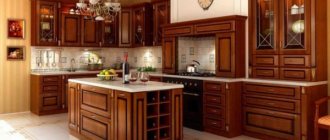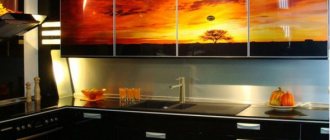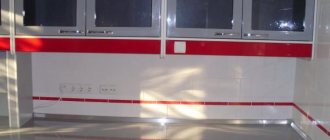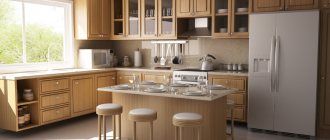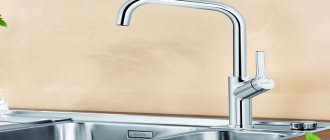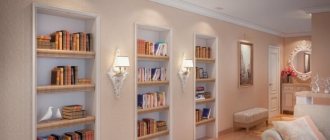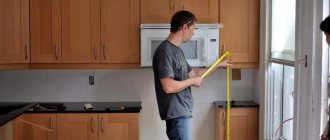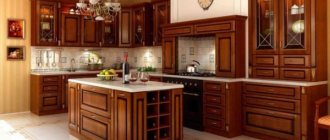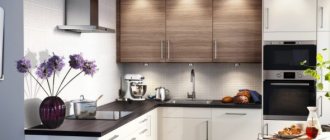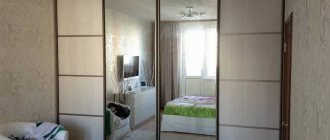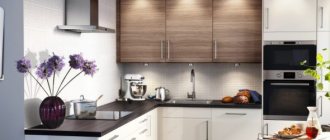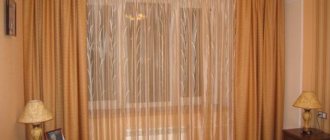Correctly selected fastening of kitchen cabinets to the wall is the key to high-quality kitchen installation and its safe operation. To prevent the story of a set from becoming skewed or its upper half falling from becoming a reality, it is important to choose a reliable method of mounting and fixing the furniture.
Before we begin reviewing possible mounting options, we note several important principles that must be observed when installing both upper and lower modules:
- Consider the material of the walls. It affects the possibility of installing the kitchen as a whole, as well as the choice of construction fasteners. Additional measures to strengthen the wall may be required.
- Cabinets should not block the natural ventilation of the room.
- The height of the upper modules is determined by the average height of family members or whoever will use the kitchen most often.
- If the wall has significant unevenness, it is better to first level it. Minor defects will not be a problem if an adjustable fastener on the bar has been chosen.
- Make sure that the installation will not interfere with sockets, switches and communications. The number and location of sockets in the work area should be thought out in advance.
- First of all, the bottom row of the headset is installed. Floor modules are also fixed to the wall using a profile, aligned with each other in height and fastened with furniture ties.
- If the kitchen is corner, then the installation of the kitchen unit begins with the installation of corner modules.
- Internal filling (drawers, shelves, pull-out baskets and other storage systems) and facades are installed last, when the furniture is securely fixed to the wall.
There are several types of fastening: on corners, furniture hinges and mounting rails. Each option has its own characteristics, pros and cons. Knowing them, you can easily determine which fastening option is needed in your case.
Mounting methods
Using dowels is the easiest way to install cabinets on structures made of different materials. In earlier times, corners were used for this purpose. Today this method has lost its relevance. It was replaced by a mounting rail. If the question of how to hang a kitchen cabinet on the wall is being decided, a specific device called a wall mount is also considered.
Mounting rail
The use of such fasteners increases the reliability of the structure. Cabinets are hung on a horizontally oriented strip, which is called a mounting rail. It has several holes. The main task is to mount this element on the wall. All that remains is to secure the cabinets with screws. The advantage of this solution is that there is no need to regularly use a building level to control the position of furniture.
The use of self-tapping screws for point installation of individual cabinets does not provide a long service life. If you fix the furniture using a mounting rail, you can not only quickly mount the set, but also get a structure that will be used for a long period. However, to ensure that the cabinets are level, you will need to carefully check the position of the mounting rail.
Loops
This type of fastener allows you to adjust the position of furniture in the horizontal plane. Installation instructions:
- A cabinet is placed between the previously drawn marking lines. It is held to mark points for installing the dowel.
- A hole is drilled in accordance with the markings.
- Then you need to take the cabinet again and hold it in its original position (between the lines on the wall). The point of the second fastening element is marked. You should first check whether the product is level.
- Install hangers for kitchen cabinets. After this, you can fix the product on the wall.
Hanging on a plasterboard wall
If you try to fix a fairly heavy structure on an unreliable partition, the furniture may collapse after a while. To avoid this, when it is necessary to hang cabinets on a plasterboard wall, the only option considered is mounting on a strip, which is an element of the partition structure. In this case, the weight of the upper part of the headset is transferred to the most reliable area, made of metal. Fixing pieces of furniture is carried out using special dowels.
If you are deciding how to properly hang kitchen cabinets, you should follow the instructions:
- A magnet is used to search for fastening elements in a sheet of drywall.
- Correlate the distance between the nearest screws inside the partition structure and the size that determines the location of the hinges on the cabinets. If necessary, use an intermediate strip for fastening. This method will allow you to redistribute the load across the entire partition.
- Heavy furniture is fixed to the gypsum board wall using anchors and long screws. The partition is drilled through to get to the supporting structure.
Mounting angles
The angle bracket is similar to hinges in that it has an eye at the end, but its right angle curved shape allows it to attach to the top of your kitchen cabinet.
The “roof”, unlike the back wall, is quite strong and can easily withstand the load exerted by the furniture with dishes and equipment placed in it. The hanging technology is also no different from the previous one.
The disadvantages and advantages of each system are not as important as the quality of the purchased set as a whole, so choose furniture based on its service life.
Hanging kitchen cabinetry is never a daunting task with an inexpensive household peg-hole drill and matching concrete drill bits. The task became more complicated when traditional Soviet methods of fastening using corners or furniture hinges were replaced by modern ones.
Useful drilling tools
Many home craftsmen have encountered the problem of the drill moving from the intended point due to the heterogeneity of the walls. This leads to the fact that the exact horizontal line is lost and it is not possible to hang a shelf or other piece of kitchen furniture straight.
In such a situation, craftsmen recommend that you independently prepare a sheet of plywood with a hole (a jig) through which the drilling will be carried out. To prevent it from moving when applied to the wall while the drill is operating, double-sided tape or sandpaper is glued to the surface oriented to the plane being drilled. For versatility, you can make several holes of different diameters. If you provide one edge with a plate attached at a right angle, then the dust will not fly away, but almost all of it will settle on this shelf.
To secure cabinets, it is often necessary to prepare holes with a specific distance. Here the conductor will also come to the rescue, on which precise markings are made, and two holes are prepared. Further actions will be aimed at drilling the first socket for the dowel in the wall, in which one side of the conductor is attached with a self-tapping screw. All that remains is to level it using a building level and drill a second hole.
Hanging on hinges
This scheme is extremely simple. The hinges themselves are most often attached to the end face of the side walls of the cabinet. This is due to the fact that the back surface is usually quite soft fiberboard and cannot support the weight of the loaded module. Classic hinges are screwed to chipboard or wood using self-tapping screws.
After marking, anchors are screwed into the wall at the required distance, onto which the eyelets of the hinges are hung. Unaccustomed to it, it may seem difficult to cope with this operation without an assistant, but with proper skill it is not difficult.
Method 3. Plastic and metal wrap-around dowels
This is the fastest option for hanging a cabinet from a plasterboard wall. The downside is a significant limitation on the maximum load. The video below demonstrates what load different types of dowels can withstand:
For fastening, special roll-up dowels for DRIVA plasterboards are used. They come in metal and plastic, with or without a drilling tip, and have large external threads and a cross slot for screwing into drywall with a screwdriver. In contrast to previous methods, these fasteners should not get into the metal frame profiles.
DRIVA is simply screwed into the plasterboard sheet in the right place, its end is flush with the plane of the wall. The force when screwing should be controlled so that the dowel does not “fall” through the gypsum board. To fasten hanging furniture, self-tapping screws or self-tapping screws are screwed into DRIVA.
The declared maximum load on DRIVA fasteners is 25 kg. At the same time, we should not forget about the additional dynamic loads that arise during operation. Craftsmen recommend using DRIVA for attaching small cabinets, shelves, plasma panels and paintings to drywall.
Another innovative solution is the use of the Fischer DuoTec self-aligning dowel. The principle of its operation and installation technique can be seen in the video:
Selecting profiles and thickness of plasterboard sheets
Drywall is used in conjunction with profiles. They are represented in an impressive number. Each type has its own functional purpose. In accordance with this, the desired option is chosen in order to achieve the reliability and durability of the partition.
The design will require a guide profile. It is distinguished by a sheller-shaped cross-section. It is used as a base for fixing the rack profile. The standard width of the shelves is 40 mm, and the width of the backrest can vary from 50 to 100 mm.
You will also need a rack profile. Its distinctive features are the presence of bends on the shelves and a width of 50 mm. There is also a ceiling option, but it is not needed, since there is no attachment to the ceiling.
If you plan to create corners that require aesthetic design, purchase a special corner profile. With its help, it will be possible to protect soft corners that are created using sheets of drywall.
Arched profiles will help you create elegant curved structures. They are represented by shelves and a back, which are integrally connected to each other. However, there are divisions that help to bend them and achieve sophisticated rounded shapes. The last possible profile option, which is distinguished by functional purpose, is a beacon profile. It is used to level the wall as a stop.
Plasterboard partition with internal lighting
Other types of fasteners
To hang several rather heavy cabinets on self-tapping screws already screwed into the wall, you can attach a strip to their back surface. This flat piece has a slot that resembles a keyhole in configuration. It is selected so that the diameter of the widest part of the hole is slightly larger than the head of the screw. The narrow part of the hole should be slightly larger than the diameter of the thread. When hanging the cabinet, the head of the self-tapping screw enters the wide part of the slot, and then moves under weight into the narrow zone, ensuring reliable fastening.
If you need to fix a fairly heavy object on the wall, made with plasterboard sheathing, then you can first make a hole with a diameter of ≈ 3 cm in the area of the fastening room, through which a solution can be introduced into the empty space, allowing you to create a strong bridge to the wall.
You can simplify the process if you correctly calculate the length of the screw. In order for the kitchen wall cabinet to be firmly fixed, several values are added up: the thickness of the drywall, the gap from the finish to the wall, the layer of plaster, the depth of the hole in the wall itself.
Furniture hinge
Another name for this fastening system is an “ear” type suspension, which is a metal plate with slots for hanging and fastening. Screwed with screws to the rear side or top and side walls of the cabinet in the corner, hung on the head of a screw screwed into the wall.
Peculiarities
Some modifications of hinged lugs have rectangular horizontal slots of about 20 mm. in places of suspension - this allows you to move furniture in a horizontal plane over a short distance. In case of inaccurate installation of the mounting dowel with self-tapping screw in height, the required height of the suspension can be set by re-hanging the ears.
Rules for wall preparation
Before installation, the working surfaces (rough) are put in order. The most important points:
- The walls are checked for distortions. In this case, you should use a level or a long-length building level.
- Assess the condition of corner areas. The walls here should make an angle of 90°C.
- Installation of sockets, chiselling of rough surfaces - these actions are completed before the process of attaching kitchen cabinets to the wall begins. The same should be the approach to the distribution of water supply communications and sewerage.
- Finishing work is in progress. Cabinets in the kitchen are installed after finishing the wall cladding, otherwise the joints between the pieces of furniture and the finishing material will be visible.
If the walls are wavy, it is recommended to remove the old layer of plaster down to the brick/concrete. Then the partition is finished from scratch. If cabinets are hung on wavy surfaces without eliminating the defects, the furniture will be positioned unevenly. This will negatively affect the interior.
Conclusion
There is no need to be afraid to hang kitchen cabinets with your own hands, as you can see, the instructions presented are quite accessible, the main thing is not to forget about the subtleties and nuances that I talked about. The video in this article shows the process step by step. If you have any questions, write in the comments, I will try to help.
Did you like the article? Subscribe to our Yandex.Zen channel
April 5, 2022
Accessories,Kitchen design,Kitchen
If you want to express gratitude, add a clarification or objection, or ask the author something, add a comment or say thank you!
Method number 1: on a wooden beam
In cases where you install plasterboard partitions yourself, you can mark out your future kitchen in advance and lay a wooden beam at the location of the mounting rail before finishing work. Choose a beam of medium width, about 8-10 centimeters, so that later you can slightly adjust the height of the cabinets. The timber is laid in the spaces between the vertical guide profile to a width equal to the width of the kitchen unit, and is attached to the main wall of the room. Subsequently, choose the fasteners for your cabinet so that its length is enough to sew through the plasterboard sheet and secure it in a wooden block. This method is usually chosen in cases where main walls are leveled with sheets of plasterboard.
Determining the hanging height
The aesthetic component of the interior and the ease of use of the kitchen as a whole depend on the height at which the kitchen cabinet hangs. There are certain standards according to which wall cabinets are installed at a height of 550 to 600 mm from the level of the countertop. This distance is quite enough so that the hostess does not touch them with her head and does not reach for the top shelf on tiptoe.
Much depends on the height of the housewife herself and the height of the floor modules. According to the standard, the worktop is located at a distance of 850 mm from the floor. This parameter can be adjusted by the height of the base, the standard of which is 100 mm.
On a note. The height of hanging the upper cabinets is dictated by the distance between the worktop and the floor level.
Also, the height of the working area from the floor is affected by the thickness of the tabletop, which varies from 20 to 50 mm depending on the material of its manufacture. The front edge of the working surface protrudes from the facade by 30-40 mm, and the rear edge by 50-100 mm. This supply of hidden space is often useful for placing communications.
Useful drilling tools
A jack of all trades always needs certain tools to work in a private house, on a summer cottage, in an apartment, or when building his own house. Many of them are not even worth purchasing if they do not require constant use. For example, for drilling, there are many different attachments that will greatly increase the functions of your drill and significantly expand them.
Let's look at some devices for auxiliary potential.
To obtain precise holes of significant diameter in different workpieces, a device such as a drilling and milling attachment will help to carry out individual milling work.
Make a milling machine out of a drill.
The next device worth mentioning is very expensive, but has the highest versatility. You will sharpen all the tools that you have on the farm, be it knives, shovels, axes, hoes, various drills, effortlessly with the universal sharpening device.
When purchasing drill attachments, be sure to check their compatibility.
Holder with clamp. With its help, you can fix the drill anywhere, use it with various kinds of devices, use it as a mini-lathe, sharpening, milling or grinding and polishing machine.
The drill holder allows you to quickly secure the drill.
All kinds of attachments are also designed for drills. These can be stops that limit the depth of drilling, platforms with which you can drill at a certain angle or perpendicularly. There are nozzles that are adapters and extensions of different designs: offset, angled, flexible.
The angle drill adapter is designed for hand and electric drills.
Metal cutting attachments turn your drill into a one-of-a-kind tool. Some resemble sheet metal shears, while others have a different feature, such as roller shears. The nozzle, called the “Cricket,” seems to cut through the metal.
The main advantage is that they do not damage the polymer coating of the metal.
There are also other attachments designed for monotype work.
- For installing aluminum rivets. There are types for both the same size and those with interchangeable bushings for different calibers.
- Tape-shaped attachment for self-tapping screws. With its help, you will significantly save time when working with plasterboard partitions or when you need to secure other materials with self-tapping screws.
- A belt sanding attachment will completely replace a sanding machine, and it will be much cheaper in cost.
- An attachment with which you can turn your drill into a hammer drill will not be superfluous.
- Using the corner pruner attachment, you can cut various cables, as well as tree branches.
- Using a variety of attachments, the drill will replace your jigsaw, circular saw, pump, and you can polish surfaces and sharpen drills.
- There are unusual attachments.
Whatever attachments we use, the main thing is that the work is enjoyable.
Computer table for a small room
This option is designed for a small room; for example, this computer table is generally located in a built-in wardrobe. The step-by-step photos show the dimensions, but you can change them so that the system unit fits into the “leg” of the table. In general, they can be made quite spacious so that nothing unnecessary is stored on the table. In this case, the tabletop for the keyboard is not retractable, but this is also a matter of taste; if you slightly reduce the working area of the lower tabletop and install a retractable shelf on runners, it will be retractable.
Photo source www.ana-white.com
Large computer desk with bureau
This table is well suited for a work office, especially if you store documents at home. Of course, there are no bells and whistles here, not even a retractable table top for the keyboard, but it is simple and reliable. The design is simple, step-by-step photos show how to make a tabletop; in this case, the bureau drawers were purchased separately, although you can do it yourself.
Photo source overthebigmoon.com/diy-file-cabinet-desk-blendtec-giveaway/
Large, beautiful and inexpensive computer desk
It’s hard to buy a computer desk at a reasonable price and one that satisfies all your needs, the author of this photo offers an excellent alternative - to make a beautiful and inexpensive computer desk with your own hands. The design consists of four parts.
- table top
- 3 cabinet drawers (for miscellaneous accessories, computer cables, etc.)
- filing cabinet for 2 drawers (boxes the size of folder files)
- printer cabinet.
The idea is to do just that, because the table can be transported and can easily be installed in a new place; repairs and rearrangements are unpredictable. The author chose a fairly simple design, the manufacture of which does not require any special tools or expensive materials, except that you will have to turn to a neighbor or a workshop to cut the wood. Here below are the tools that the author used.
Materials:
- 3 sheets of MDF (you can use maple veneer plywood, but it is 3 times more expensive)
- 2 sheets of 1/8 MDF or fiberboard - wood glue
- hole filler
- 5 pairs of drawer roller slides
- 7 drawer handles - 1 pair of cabinet door hinges
- 4 liters of primer
- 4 liters of paint
- brushes and rollers.
For the assembly procedure, see the step-by-step photos; if you are interested in the nuances, you can read in detail on the source website, link under the gallery.
Photo source www.instructables.com/id/great-looking-inexpensive-computer-desk
Working computer desk studio
The desk is a little bulky, but if your work involves a computer, almost everything is provided here. It is unlikely that you will be able to buy such a model in a store, and making a computer desk with your own hands will cost five times less. In addition to boards and plywood, you will need tie screws, nails and wood glue. Special tools include a circular saw and a grinder.
Photo source: jackdanielsrecordings.com/my-diy-studio-desk-build/
Adjustable computer desk
An interesting idea for a computer desk; in a store you are unlikely to find a model with an adjustable tabletop height. There are some, but basically you have to disassemble the structure in order to adjust the desired height, but here the whole trick is in the chain drive. That is, they simply used bicycle sprockets with a chain. Well, of course, it’s not easy, you need welding and other serious tools, but you’ll get a very comfortable table in an industrial style. How to make it, look at the step-by-step photos.
Photo source kevinjantzer.com/diy-adjustable-standing-desk/
Simple DIY computer desk
You can make such a simple computer desk with your own hands, say, for a summer house. Of course, it’s not exactly computer-based, but rather universal. You can call it a written one, even a kitchen one; in my opinion, it’s quite a suitable option for a dacha. There is a drawer under the tabletop that can be used as a regular drawer or converted into a keyboard. It’s quite simple to make; all the steps are indicated in the diagrams with step-by-step photos.
Photo source www.thedesignconfidential.com/2012/08/free-diy-furniture-plans-build-pottery-barn-inspired-hendrix-large-desk
Mounting options
There are 2 methods by which fastenings for kitchen cabinets are made. Installation is carried out:
- One line, that is, the location of the fastener is equidistant from the ceiling;
It is considered the most common type of accommodation. This way you can easily secure the cabinets yourself.
This method is used much less frequently, since its implementation is much more complicated than a linear fastening scheme.
The first method is popular because you can use only your own strength to attach kitchen cabinets, without turning to outside help.
The choice of option is determined by the number, size and depth of wall cabinets.
The second option for attaching fixation items is less common among ordinary people. This is because the roof of this furniture is used as an additional surface.
Any of the proposed variations is perfect for both a room with a small area and a large one.
And all because they do not have any effect on the fullness or compactness of the room.
When choosing a method, only the interior and design change.
Tips for hanging cabinets
There are several rules for how to attach kitchen cabinets to the strip.
- The height of the wall cabinets should be such that adult family members can freely take the item on the top shelf from the floor.
- Cabinets must not block ventilation outlets.
- The fastenings must be as strong as possible so that the cabinets can withstand quite a lot of weight - their own, food and kitchen utensils.
Hang cabinets on drywall
Often apartment owners have to solve the question: how to hang the kitchen on drywall.
As you know, such material is not durable, but we need guarantees of high-quality installation - who wants a cabinet to ever collapse on the floor?
The problem is still doable.
Fastening methods:
- Butterfly dowel. Only suitable for light wall-mounted modules weighing up to 5 kg. The dowel body is aluminum, made in the form of a collet (a hollow cylinder with longitudinal cuts). When the screw is screwed into the dowel, the antennae move apart and are pressed into the surface of the hole in the sheet.
- Mounting rail. It is attached to a sheet and a wooden frame - this ensures higher reliability of fastening. Knowing in advance that the cabinets will be hung, you need to, if possible, take care of a more durable base (mortgages) under the drywall in the form of timber.
- In order to secure very bulky furniture, they also use additional fasteners: decorative cable. It is attached to the ceiling. In addition, tubes coated with a layer of chromium are used. They are screwed to the floor and serve as a frame.
Using the Mounting Bar
The suspension structure is based on a strip of metal with holes prepared in advance in production. It can be up to three meters long, but most often it is cut into pieces of the required length. The strip itself is not flat, but slightly wavy, which gives it rigidity.
It is attached to the wall with self-tapping screws and dowels or anchors if the cabinets are heavy. The furniture itself is equipped with special hanging mechanisms, the legs of which stick out from the back and cling to the bar when hanging.
The big advantage of this system is its ease of installation. One person can easily handle it. The task is made easier by the fact that the mounting bar itself just needs to be leveled, and the attached cabinets can be moved along it.
Advantages and disadvantages of the plank
This simple design has a number of advantages, which is why it has gained its popularity:
- Even non-professionals - people with basic construction skills - can cope with the installation.
- When installing adjustable awnings, there is no need to measure and drill holes for each wall hanging cabinet separately. The general level is reflected.
- Using anchor bolts you can adjust the position of the cabinets. They can be placed on the same level, regardless of the flaws of the wall.
- Unlike fastenings for wall-mounted kitchen cabinets with dowels, a design with a strip is considered more “durable” and reliable. Even if a couple of screws loosen over time, the rest will hold well even when the cabinets are as full as possible.
The system has no global shortcomings. The only thing you should keep an eye on when purchasing a bar is the quality of the material. Low grade metal will bend a lot and may even break during furniture installation.
The locking mechanisms of kitchen cabinets have to endure heavy loads.
Let's sum it up
You should not be afraid of installing kitchen cabinets yourself, because if you follow all the nuances of the instructions, it is impossible to make a mistake. The most important thing is to have free time, the necessary tools and an assistant who, if something happens, will hold the cabinet, hand you the necessary items, and look from the side to see if the furniture is hung evenly.
Buying a ready-made kitchen set today is not a problem. The industry offers consumers a huge selection of sets made from various materials - from cheap laminated OSB boards to expensive natural wood or artificial stone. But for several reasons, the purchased option cannot be considered optimal for everyone. In a special article we will look at how to make a kitchen set yourself, which designs are the most convenient and reliable.
Bolts, anchors or tires?
To ensure that the fastenings are reliable and the filled cabinet does not fall at the most unfortunate moment, you should take into account the material used to make the walls and furniture. Carefully consider the type of fastening.
How to fasten and what fittings are most optimal for a brick, concrete, wooden wall?
For a wooden wall of a country house, fastening with countersunk screws made of hardened alloy would be optimal. The most effective installation is with self-tapping screws with a large pitch and double-start thread.
It is better to attach shelves to a concrete and brick base using dowels, plugs, metal bolts, and plastic fasteners. You can strengthen the fittings in the holes after the drill with gypsum mortar.
Molly or butterfly screws will securely secure hanging furniture to a plasterboard wall.
For open shelves with light loads, decor, and lighting, you can use plastic butterfly dowels and drill dowels.
Hanging storage systems for dishes, food, and equipment should be mounted on classic metal fittings. For example, you can buy regular dowels made of durable alloy or molly (butterfly dowel in a metal version).
If it is impossible to reach the wall through the sheathing, you can use wooden bookmarks. The thickness of the embedded beam should be equal to the thickness of the transverse frame. If these numbers do not match, the structure may become deformed. The thickness of the timber is adjusted according to the profile sample. A metal butterfly screw is optimal for fastening hardware.
The attachment is attached directly to the bar made of bars. To enhance the load-bearing capacity, use the longest length of the plank: for example, along the width of the entire set of hanging furniture.
The two most proven types of fasteners are:
- mounting rail;
- classic bolts and screws.
Profile thickness and drywall type
Attention!
Choose the correct profile thickness. It depends on the thickness of the metal used as the material.
For light partitions, a profile with a thickness of 0.4 mm is suitable. But its use to create a partition that is attached to the floor is considered irrational. Any serious loads will ruin the resulting structure. Profiles with a thickness of 0.45 mm are stronger, but for the described option it is better to choose a thickness of 0.55 mm. It guarantees excellent resistance to stress and wear. If desired, even shelves can be mounted in such a partition.
Additionally, take care of the selection of the drywall sheets themselves. Many people prefer the universal option. It comes in gray with blue markings. If the partition is installed in the kitchen or bathroom, choose a moisture-resistant or fire-resistant option. A plasterboard sheet that is resistant to both moisture and elevated temperatures is optimal. Its price is high, but its characteristics fully justify it.
Installation method
To properly secure kitchen wall cabinets, you need to select a tool in advance and strictly follow the installation technology. It’s easier to do the work with 4 hands, but 1 person can do it
Of course, this will take a little more time and will require extreme concentration, accuracy and caution.
An important factor is the reliability and quality of fastening of each part of the headset to the wall.
Preparatory stage
Before starting the process of drilling surfaces and direct installation, you need to perform the following steps:
- Cleaning and leveling walls. The easiest way to do this is with drywall. First, you need to secure a frame of profiles to the wall, on which the structure of the cabinets will be supported.
- For corner kitchens, the angle between the two planes should be maintained at 90 degrees. If the curvature of the walls is insignificant, you can simply plaster them.
- Applying basic markings. Using a perpendicular, a construction pencil and a level, you need to schematically arrange the attachment points and select the height of the structure.
- If the situation requires it, you must first install all sockets and lighting fixtures and attach all related elements.
- Before starting work on the installation of kitchen cabinets, the walls must be painted or wallpapered - no repair work should be carried out after installation.
Hanging height indicators
It should be convenient to use the set, so the height of the cabinets directly depends on the height of the owners and the anatomical features of their figure, and the features of the room.
Before you start assembling the set into a single “wall”, you need to decide on the height at which the furniture will be hung.
Main criteria and numbers:
- The drawers should be tactile and located at eye level. On average, the distance from the plane of the table top to the top cabinet is 55-65 cm. In this case, a person must reach the very top shelf without the risk of dropping the desired item and without the use of auxiliary objects (chairs, benches, etc.).
- If you do not plan to mount a table top or the lower part of the set, then the ratio of human height and fastener height should look like this:
- up to 165 cm – 175-180 cm;
- 165-157 cm – 185 cm;
- 175-190 cm – 200 cm.
To correctly carry out these manipulations, preliminary calculations must be made.
Required tools and materials
To carry out the work quickly and efficiently you will need:
- Drill or hammer drill with drills or augers. For brick and concrete, the impact mode should be used; for other surfaces, regular drilling will be sufficient. When working with tiles, you need to stock up on drill bits with pobedit tips.
- A screwdriver, which will be used to tighten the screws for attaching the holders to the cabinets.
- Construction pencil and tape measure.
- Level for marking the location of cabinets and adjusting awnings.
- Stable ladder.
Tools and materials
Working tools are required: level (water level), tape measure, marking items (pencil, square), wrenches and screwdrivers (of various shapes), drill (drills), screwdriver (bits), knives, hammers, hacksaw, etc.
Before installing the cabinets, you need to make sure that you have completed the electrical installation or finishing work.
If you have to level the walls, you will need a spatula and other construction supplies. A hammer drill is needed if you have to work with concrete material.
Material base:
- screws for installation;
- parts for mounting the headset;
- self-tapping screws (screws);
- nails;
- loops;
- screeds;
- tires.
To level the surfaces you will need chipboard and putty.
If everything is clear with the internal arrangement of the cabinets, then you should pay special attention to the door opening system.
Now we need to start soaking the walls and the theoretical installation plan.
It should be taken into account that when hung using a rail, the cabinet will not fit tightly to the wall and its lower part will slightly extend onto the kitchen apron.
Methods for assembling hinged elements
Any disassembled kitchen is a set of parts made of chipboard and MDF, fittings, and fasteners. Using all this, you need to assemble the cabinets. The kitchen is mainly equipped with upper and lower cabinets.
Methods for assembling a kitchen set:
- In pairs. The master assembles the upper and lower cabinets and then installs this pair.
- First, assemble the upper cabinets, and then the lower ones.
- The lower elements are assembled first, and then the upper ones. Many people find it more convenient to hang the upper elements while standing on the countertop.
If you collect everything at once and then install it, you can clutter the entire apartment, but sometimes this is not possible, especially if the apartment is one-room or heavily cluttered with furniture.
Types of modern wall kitchen cabinets
Along with the appearance, the filling of the cabinets has changed. They have acquired greater functionality and ease of use. There are cabinets equipped with a roll-out system, racks that rotate around a rigidly fixed center. This creates additional ease of access to kitchen utensils and food supplies.
All wall kitchen cabinets are attached to the back wall and have the same design, consisting of a frame, shelves and front. Chipboards are used to cover the back wall; solid wood, MDF, chipboard, and LMDF are used for the facade. The industry produces several types of wall cabinet designs:
- Open type, which are not much different from shelves and racks designed for storing various works of art, vases, photographs, and printed literature. On shelves that are not closed with doors, you can conveniently place spices in decorative boxes, vases with cookies and sweets, containers with coffee and tea.
- Closed type, which have standard shelves closed with hinged doors. The cabinets are designed for storing kitchen appliances, detergents, sponges, napkins, and for building in multi-tiered drying structures.
- Combined type, which combines all the characteristic features of closed and open wall cabinets.
There are not only simplified versions of wall-mounted kitchen cabinets, but also a variety of square and corner ones designed for drying dishes and installing exhaust hoods. They all have different shapes, sizes, color options, and filling capacity.
Cabinets with built-in drying racks for plates, cups, and glasses are usually hung above sinks with a kitchen faucet. Structures are installed above the kitchen stove where exhaust devices are placed.
Corner designs allow you to use all the free space of wall cabinets, including areas that can be difficult to reach. They can be shaped like the letter G; trapezoidal and straight wall cabinets with beveled corners are available. With wall-mounted vertical cabinets, the ceiling height visually increases and the interior takes on a complete look.
Lately, tall vertical kitchen wall cabinets that reach the ceiling surface have been gaining popularity. The design is especially relevant for small kitchens and families who have many different kitchen appliances for cooking. True, to get to the upper shelves, you will have to use small stairs.
Horizontal wall cabinets visually make the kitchen wider, expanding its boundaries. And the upper and lower niches of wall cabinets increase the space for storing necessary items and equipment in the kitchen.
How to place it correctly?
There are a few simple rules:
- accessibility of food, dishes and other kitchen utensils stored in the closet - to ensure this possibility, it is recommended to place pieces of furniture at a given distance from the countertop, and not under the ceiling;
- cabinets should not interfere with air circulation, so they are installed next to the ventilation grille, and it is prohibited to close the entrance to the duct;
- pieces of furniture in the kitchen are placed so that they do not spoil the geometry of the room.
The distance is enough to place all kitchen appliances on the table. Moreover, more often they choose an option within 45-50 cm. A distance of 65 cm and above in most cases determines the position of the hood (from the countertop to its lower edge).
You should also focus on the growth of the residents of the house. Possible options:
- If a person's height is between 155-160 cm, the recommended height from the floor to the top shelf is 175 cm.
- If your height is 160-170 cm, the top shelf should be located at a height of 190 cm.
- For tall home owners (height 170-190 cm), a suitable option is when the top shelf is at a height of 200 cm.
If you do not follow these recommendations, it will be difficult to freely use dishes and kitchen utensils located in cabinets. You will have to use a stool for this purpose. In addition, you need to check at the installation stage that the hanging furniture is level. Any distortions can lead to the collapse of part of the kitchen equipment. In this case, the appearance of the interior also deteriorates. A building level should be used to check the position of the cabinets.
Almost always, wall-mounted and floor-standing pieces of furniture are placed so that they are on top of each other. Otherwise, the set will not look organic and symmetry will be lost. If necessary, cabinets are positioned higher or lower than existing standard values. However, before you finally drill holes in the wall, you should make sure that a person can easily reach the top shelf. Recommendations for calculating the installation height of cabinets:
determine the height of all residents of the apartment, take the average value - if you focus on only 1 family member (the tallest or shortest), then the rest will be uncomfortable using the furniture; take into account the dimensions of the upper cabinets; The most harmonious look is the set, which occupies most of the wall, for this reason, when choosing, you need to focus on the height of the ceilings of the room; sometimes it is important to make the apron high enough (for example, when installing specific decorative elements, the upper cabinets are raised additionally); The style direction in which the set is made is also taken into account (sometimes it is necessary to place cabinets at some distance from each other)
Selecting fasteners and preparing walls
Before you begin the process of installing cabinets, you will need to decide on the type of fittings that will be used during the work. After all, factory-made furniture does not have any special hanging hooks or other devices, because it is assumed that the installation will be done by qualified craftsmen.
Table 1. Types of fastenings
| View, illustration | Description |
| Rail | This is one of the most popular and modern mounts. It consists of the following components: a mounting plate in the form of a metal strip and a canopy in a plastic case, which has a hook for attaching to the rail. The bar can be of various lengths (up to three meters). It is attached to the wall using dowels and screws at a certain distance from the floor. Canopies are installed in the interior of the structure so that the hooks protrude beyond the wall. The hangers provide the ability to adjust the position of the hooks. Fittings of this type have the following features:
|
| Furniture hanger | This is the most common fittings, which has been known to everyone since the times of the USSR. It is a type of metal plate with holes for screws. The hardware is attached to the cabinet back or side and then hung on an anchor in the wall. Features of fastenings of this type:
|
| Ikea mount | This type of fittings has appeared quite recently; it is used in almost all cabinets from Ikea. The fittings have the form of a corner, which is attached to the side of the cabinet from the inside, and its other part with a voluminous round slot for installation is located in the hole in the back wall. Next, markings are placed on the wall and a screw is screwed in, after which the cabinet is hung on it. When the screw head goes through the hole, you will need to attach a plastic attachment to it. Thus, the cabinet is securely attached to the wall. Its location can be adjusted as far as the slot in the corner allows. |
| Hanging corner | This method of installing wall cabinets has been known for many years - our grandparents’ furniture was attached to such corners. It is worth noting that hanging corners are the same furniture hinges, only in a bent form. Their main difference is that they can be fixed to horizontal walls through slots. This system is reliable, and the suspension can be adjusted if desired. |
Preparing uneven walls
Wall cabinets can cover any surface defects, and sometimes they don’t even have wallpaper behind them. In some situations, preparing walls before installing cabinets is not necessary, but professional craftsmen still recommend not skipping this step - sometimes unevenness is so noticeable that it becomes impossible to perform a high-quality installation.
If the wall is wavy, you can’t hang cabinets on it
The process of further work will depend on the degree of deformation of the walls. Most often, preparation is needed for “bare” surfaces where there is no layer of plaster, but this happens very rarely, because all pieces of furniture are usually transported after finishing work is completed.
The most common method of finishing walls is called beacon plaster. It is suitable for any brick, cinder block, concrete floors. The technology is as follows:
- First of all, the wall is thoroughly sanded to remove any build-up of mortar.
- Next, a primer is applied to the surface in several layers, each layer being dried.
- Next, beacons are installed on the walls. They are a type of metal or plastic slats. They are fixed with plaster. To begin with, two longitudinal strips are placed, and ropes are stretched between them, and the rest of the beacons are already secured along them.
In the process of fixing beacons, a building level is used
- Next, they begin to apply a solution on top of these beacons on the wall, and then level it.
- Typically, metal beacons are removed from the walls after a few hours, when the solution has hardened a little. The remaining holes can be plastered. At the same time, plastic beacons are often left in the walls.
This is what the whole process of finishing walls with beacons looks like
If there is already an (albeit uneven) layer of plaster on the wall, then such work is not worth doing. It will be enough to level the surface using finishing plaster.
Important point! Despite the fact that the technology of wall finishing may seem simple, it has some important nuances that not every beginner can understand. Therefore, if you doubt your skills, it is better to turn to professional craftsmen.
Wall decoration is a rather painstaking job that requires care.
If you don’t want to putty the wall and lay tiles, there is another interesting way to prepare the surface for hanging cabinets. To test the method in action, you will need to screw two wooden planks to the wall in a horizontal position.
These wooden planks will serve as tires on which the fittings are attached. Thus, all hanging parts of the furniture do not come into contact with the walls, but are supported by slats.
The only negative is that you have to install a solid apron on the same slats, which is located between the wall and floor cabinets, otherwise an unsightly gap will be visible.
Using wooden planks you can hide various wall irregularities
Installation instructions
- After completing the preparatory work, you can begin assembly. After screwing the screws, you need to align the hooks in one position and make sure that they are at the middle level. Canopies must be secured in one position. The protrusion of the fastening part (has a hook configuration) should be 2 mm in relation to the rear of the wall.
- If you planned to cut the tire, then it’s worth taking care of the preparations.
- Holes are made on the pre-marked wall for fixing the tire.
- The body of the hanging furniture must be mounted on a tire. The reference point is the plane of the wall. The next fastening of wall kitchen cabinets is carried out based on the previous one.
- The next step is the sequential fixation of installation objects using fasteners. A clamp is used for this. To prevent the surface from being damaged, a thin layer of insulating material must be laid.
- Next, you need to drill holes in the housings. To avoid cracks or splinters, use plywood or wood overlay. After preparing the apertures, the elements are connected with ties.
- After hanging and fixing the drawers, the doors should be screwed on. To do this, they must be laid out on the floor in such a way as to attach the loops to special niches. After this procedure, installation to the housing occurs.
How to properly apply markings on walls?
90% of successful work on hanging cabinets depends on correct marking. So, how to hang a kitchen cabinet perfectly level on a rail? You just need to carry out the markings consistently and correctly.
- Install the base cabinet and measure the distance from it to the wall cabinet. According to GOST, it should not be less than 45 cm, in practice - 50-60 centimeters.
- Using these marks, draw a line or stretch a thread, always measuring everything according to the level.
- Already from this line, measure the height of your cabinets and also draw it or mark it with thread.
- Set aside the required distance from the top edge at which you have attached awnings or other fittings for hanging cabinets, and approximately mark the holes.
- Measure the width of the mounting strip and make sure it will not protrude over the top of the cabinets.
- Place the strip along the top line or slightly below (depending on your measurements) and mark the holes as shown above.
Finishing and useful recommendations
Finishing is also easy to do yourself. Initially, irregularities and seams are sealed. The joints are glued with a mounting mesh, and then leveled using starting putty. Rub and level the putty with an abrasive mesh or sandpaper.
After this, finishing begins. Choose any material at your discretion. Drywall is universal, so it can be easily combined with any options. Among the traditional ones are wallpaper or paint. If desired, you can leave the drywall itself. If the work is done well, it looks attractive. This option is suitable for high-tech or minimalist design.
Living room with plasterboard partition
The partition is a useful element of the interior. With its help, they zone the space, achieving individuality and originality of the interior. Creation is a feasible task for everyone, so you can save on calling specialists.
- There is no need to select a beam that is ideally suited to the thickness of the partition - the profile will set the required thickness of the frame. The pieces of timber are screwed to it with self-tapping screws during the installation process and do not dangle;
- The metal profile jacket protects the timber from cracking and provides additional rigidity.
The embedded elements are pre-installed into a wall or partition made of plasterboard at the required height during the installation of the frame. Each fastener can withstand a pullout load of 35 kg; it turns out that furniture with a total weight of 70 kg can be hung on two anchors. In this case, the total load is distributed over a large number of dowels, so this mount can withstand the weight of cabinets from 50 kg. Sets of modern kitchen sets and wall furniture often include metal rails - a rigid shaped strip with holes and bends for hanging kitchen cabinets on special hooks.
To do this, hatch holes are cut into the gypsum board so that you can drill into the main wall with a hammer drill and install anchors. The anchor consists of a metal or plastic dowel and a long threaded screw or hook. I do not take into account chemical dowels, because they are used quite rarely and have some difficulties in installation. The above methods of strengthening are the most common and most reliable.
But you can hang objects on plasterboard walls without using a mortgage. Instead, you need to use special fasteners: butterfly dowels, anchor bolts and brackets. Drywall is a regular guest in modern renovations.
This is an ideal material for leveling walls, assembling complex ceiling structures, installing partitions, niches and other decorative elements. Along the length of the working part, expansion anchors have two standard sizes, which are 13 mm and 26 mm. As in the previous case, the first size is used for single plasterboard, and the second is intended for double-layer gypsum board . Depending on the load-bearing load, it can be equipped with M4, M5 or M6 threaded screws. For example, the MOLA 5/13 expansion anchor is equipped with an M5 threaded screw and is designed for fastening to single plasterboard.
From my personal experience, I can immediately say that almost anything that can be found in any residential apartment can be hung on a plasterboard wall, however, for reliable and safe installation, it is important to correctly calculate the fastening points and correctly select the appropriate fasteners.
Correct marking of the space for the partition
The frame is the basis of the partition. He admits that there will be about 25 cm between the partition and the ceiling. A larger distance is not recommended, since in this case reliability will be lost, and it is unlikely to add aesthetics to the room.
Marking
Frame installation begins with markings. A chop cord and level will help with this. Initially, the required height of the partition is selected from sheets of material. It is preferable to do this along the bottom corner of the room, measuring from the ceiling. This will eliminate visual unevenness, even if there is a gap between the ceiling and the structure.
After this, marks are left on the wall to which the frame is attached. They are performed using a chokeline - the chop cord is pulled back and abruptly released. The result is a reference line on the wall. It is recommended to verify its correctness using a building level.
If you wish, you can start marking from the floor, this will eliminate the need for measurements. The resulting line is then accurately transferred to the surface of the selected wall or walls. Additionally, you can use a plumb line. It is this line that becomes the control line for placing the guide profile.
It is not difficult to determine the boundaries of the resulting structure. To do this, the thickness of the selected sheets of drywall, putty and the planned finish is added to the marked parameters. If you are planning an arch or doorway, take this into account during the marking process.
Creating a wireframe
The next stage is installation of the frame. It involves attaching a guide profile to the floor. choose the one that has the greatest load-bearing capacity to eliminate possible difficulties in subsequent operation. Dowels are used to secure the profile. They are placed at a distance of 50-80 cm from each other. The specific distance depends on the dimensions of the structure.
Frame base for partition
Next, fix the rack profile, starting from the edges of the guide and in the place where the doorway will be located, if it is planned. The fixation should be of the highest quality, so do not skimp on fittings. This will prevent movement or deformation of the finished structure. The rack profile is mounted along the length of the entire frame. The distance is fixed - 60 cm. Metal screws are used for fastening.
At this point, the installation of the frame is considered complete. It is recommended to ensure its strength and, if there are minor flaws, provide additional reinforcement. Rigidity is enhanced by installing cross bars made of profiles. The frame itself must be double-sided. This will ensure the rigidity of the partition itself. If you wish, pay attention to the video, which will allow you to understand the principle of operation. In the video you will get acquainted with the features of installing profiles and their fastening.
Covering the partition with plasterboard
The next stage of work is the installation of drywall on the created frame. The material has a beveled edge that hides the seams at the joints. However, it is recommended to remove it from the first row of sheets. The edge is cut with a knife to a width of approximately 50 mm.
Covering the partition with plasterboard
Drywall is attached to the frame using self-tapping screws in increments of 200-250 mm. It is recommended to recess the screws by approximately 1 mm. This will cover one side of the frame. embedded parts are mounted inside. These include lamps or supports for shelves, laying pipes and electrical wiring, if required, laying sound and heat insulating material. However, this is not always required for the partition.
Then perform similar actions on the other side of the structure. At this point, the frame covering is considered complete. Now we begin finishing, which will add elegance and aesthetics to the interior.
